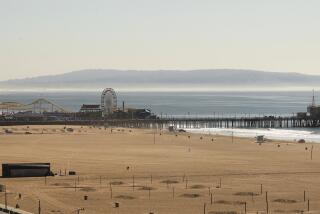Time to Decide Who’s Best, East or West?
- Share via
COLORADO SPRINGS, Colo. — It’s the Big Apple vs. the City by the Bay, East Coast against West Coast, sentiment or scenic beauty.
Choosing between New York and San Francisco as the U.S. candidate for the 2012 Summer Olympics is sure to be tough for the U.S. Olympic Committee’s board of directors.
“I think that both cities have put forth convincing cases, and it’s going to be difficult to choose between them,” said Anita DeFrantz, International Olympic Committee member from the U.S.
The vote will take place Saturday during the USOC’s annual meeting in Colorado Springs. The winner will face up to a dozen international cities -- Toronto, Rome, Paris, Moscow and Rio de Janeiro are among the possibilities -- when the IOC makes its selection in 2005.
Both cities will get a final chance to prove their cases this weekend, when each group will make an hourlong presentation to the USOC’s board of directors.
New York’s infrastructure and cultural diversity are strengths, and it could be the sentimental favorite after the Sept. 11, 2001, terrorist attacks.
San Francisco offers ideal weather conditions, scenic vistas and a wide range of world-class venues already in place.
Both cities have international appeal as tourist destinations and are U.S. icons, with the Statue of Liberty in New York as a symbol of freedom and San Francisco’s Golden Gate Bridge as the country’s gateway to the Pacific.
“I think we’re fortunate to have two excellent cities to chose from, and I think either one will be a good representative internationally,” said Bill Hybl, another IOC member from the U.S. “New York has a reputation around the world as being a very dynamic city and San Francisco is a very beautiful city.”
Deputy New York Mayor Dan Doctoroff, founder of NYC2012, said New York’s biggest asset could be the chance to provide a powerful Olympic story. He said New York would compare to the selections of Beijing, in the world’s most populated country, and Athens, site of the first Olympic Games.
“Those two are no-brainers because of the compelling stories they tell, but I think New York could have the greatest Olympic story of all,” Doctoroff said.
“If you think about what draws people to the Olympic movement, it’s something that New York lives every day. And if you look at it from an athlete perspective, I think New Yorkers will tell you this is the most competitive place in the world.
“As the Frank Sinatra song goes, ‘If I can make it here, I can make anywhere.’ ”
The keys to San Francisco’s bid are its venues and weather.
Most of the venues are clustered in four areas, which organizers call the “Ring of Gold,” and 80% are already in place. The clusters are in San Francisco, Oakland/Berkeley, Stanford and San Jose/Santa Clara.
Canoeing and rowing would be held outside Sacramento. Cycling would be north in the wine country and equestrian would be held at Fort Ord near Monterey. The rest of the venues -- 92% -- would be within 32 miles of the Olympic Village.
And the weather should be perfect, with an average heat index of 76 and almost no chance of rain at the time the games would be held.
“We’ve involved athletes in every step of the process, and we wanted to make sure we had the best possible conditions for the athletes to excel,” said Anne Cribbs, a former Olympian and head of the Bay Area Sports Organizing Committee. “And we really feel like our bid creates the best competitive conditions.”
New York will spend about $900 million of its $2.4-billion budget to upgrade and build new facilities.
That will include three new arenas, a 25-acre park in Brooklyn for beach volleyball and archery, and the conversion of two polluted lakes at Flushing Meadow into rowing and canoeing courses.
They would surround the Olympic Village in West Queens, which would sit on a waterfront site just across the Hudson River from the United Nations.
New York’s infrastructure also should boost to its bid.
With subways, buses and ferries, the city is designed to move millions of people every day. NYC2012 officials have used that system to their advantage, creating a transportation “X” around the Olympic Village that will keep from clogging the city.
The plan will use existing rail lines that run from the Meadowlands in New Jersey to Flushing Meadow to move athletes and officials east and west. The ferries that run between Manhattan and Long Island would be used to move people north and south, and buses would be used for local transportation.
Bid officials have broken the transportation needs down to 30-minute intervals and in such detail that they already know 830 buses, 92 ferries and 13 trains would be needed on Aug. 3 -- the busiest day of the 2012 Games.
“I know that one of the biggest concerns about New York hosting the Olympics is getting people around,” Doctoroff said. “But with our plan, the athletes will almost never have to travel on the city’s streets.”
Transportation would be more of an issue in San Francisco with the venues so far apart.
More to Read
Go beyond the scoreboard
Get the latest on L.A.'s teams in the daily Sports Report newsletter.
You may occasionally receive promotional content from the Los Angeles Times.







